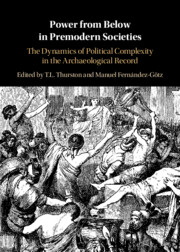 Power from Below in Premodern Societies
Power from Below in Premodern Societies Book contents
- Power from Below in Premodern Societies
- Power from Below in Premodern Societies
- Copyright page
- Contents
- Figures
- Contributors
- Preface
- One Power from Below in the Archaeological Record
- Two Fragmenting Trypillian Megasites
- Three Structure and Agency
- Four Power Requires Others
- Five “And Make Some Other Man Our King”
- Six Societies against the Chief? Re-Examining the Value of “Heterarchy” as a Concept for Studying European Iron Age Societies
- Seven Peasants, Agricultural Intensification, and Collective Action in Premodern States
- Eight The Spread of Scribal Literacy in Han China
- Nine Confronting Leviathan
- Ten The Emergence of Monte Albán
- Eleven Dispersing Power
- Twelve The Perplexing Heterarchical Complexity of New Guinea Fisher-Forager Polities at Contact
- Thirteen Restoring Disorder
- Index
- References
Twelve - The Perplexing Heterarchical Complexity of New Guinea Fisher-Forager Polities at Contact
Published online by Cambridge University Press: 08 October 2021
- Power from Below in Premodern Societies
- Power from Below in Premodern Societies
- Copyright page
- Contents
- Figures
- Contributors
- Preface
- One Power from Below in the Archaeological Record
- Two Fragmenting Trypillian Megasites
- Three Structure and Agency
- Four Power Requires Others
- Five “And Make Some Other Man Our King”
- Six Societies against the Chief? Re-Examining the Value of “Heterarchy” as a Concept for Studying European Iron Age Societies
- Seven Peasants, Agricultural Intensification, and Collective Action in Premodern States
- Eight The Spread of Scribal Literacy in Han China
- Nine Confronting Leviathan
- Ten The Emergence of Monte Albán
- Eleven Dispersing Power
- Twelve The Perplexing Heterarchical Complexity of New Guinea Fisher-Forager Polities at Contact
- Thirteen Restoring Disorder
- Index
- References
Summary
Some two and a half decades ago, Carole Crumley noted the “almost unconscious assumption of hierarchy-as-order … among social scientists, especially in the area of complex society” (1995: 3). At the time, the prevailing view was that large-scale, complex groups were functionally impossible without a centralized power and hierarchical organization. Yet, Crumley went on, any number of biological and social structures that are hard to characterize as hierarchical are, by most any measure, complex. Drawing from cognitive scientist Warren McCulloch’s (1945) work on the collective organization of the brain, she dubbed these organizations heterarchies, where heterarchy is “defined as the relation of elements to one another when they are unranked, or when they possess the potential for being ranked in a number of different ways, depending on systemic requirements” (Crumley, 1979: 144; 2015: 1)
- Type
- Chapter
- Information
- Power from Below in Premodern SocietiesThe Dynamics of Political Complexity in the Archaeological Record, pp. 272 - 294Publisher: Cambridge University PressPrint publication year: 2021


